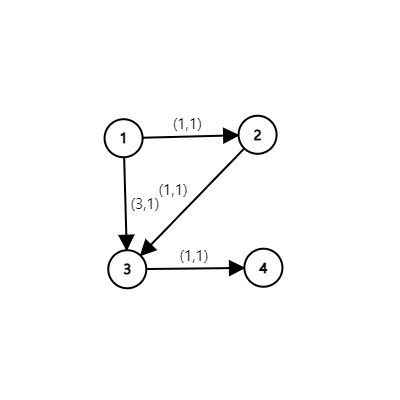백준 KCM Travel(10217)
1. 힌트
1) 단순 다익스트라에서 비용이 을 넘지 않는 경로로만 이동하는 최단 경로는 정답이 아닙니다. 반례는 다음과 같습니다.
1
4 4 4
1 2 1 1
2 3 1 1
3 4 1 1
1 3 3 1
->2
2) 이 최대 으로 상당히 작은 것에 주목합니다. 그래프를 변형해서 모델링해볼 수 있습니다.
3) 정점을 2차원으로 늘려서 생각합니다. (번 정점, 만큼 비용을 사용함)으로 정의하면 전체 정점의 개수는 이므로 이 정도면 오래걸리긴 하겠지만 의 다익스트라로 해결할 수 있습니다.
2. 접근
1) 비슷한 문제를 풀어본 적이 있던가?
다익스트라로 한 정점에서 나머지 모든 정점으로의 최단 거리를 구할 수 있습니다. 여기서 거리는 소요 시간이므로 가장 짧은 시간이 소요되는 경로부터 확인해보면 되는데, 이하로 비용을 사용해야 하는 것이 발목을 잡습니다. 대개 이런 경우 그래프를 색다르게 모델링하면 풀 수 있습니다. 특히 이 문제에서는 이 이하인 것이 눈에 띕니다.
따라서 정점을 2차원으로 늘려서 생각합니다. (번 정점, 만큼 비용을 사용함)으로 생각하고 번째 정점에 비용을 얼만큼 사용했건 다익스트라로 가장 짧은 소요 시간을 찾습니다.
3. 구현
public class Main {
static int N, M;
static ArrayList<ArrayList<Tuple>> adj;
static final int INF = 987654321;
static int dijkstra() {
PriorityQueue<Tuple> pq = new PriorityQueue<>();
pq.offer(new Tuple(1, 0, 0));
// N번 정점까지 M비용을 소모했을 때 최단 거리
int[][] time = new int[N + 1][M + 1];
for (int i = 0; i <= N; i++) Arrays.fill(time[i], INF);
time[1][0] = 0;
while (!pq.isEmpty()) {
Tuple t = pq.poll();
int here = t.num;
int hereCost = t.cost;
int hereTime = t.time;
if (time[here][hereCost] < hereTime) continue;
for (Tuple e : adj.get(here)) {
int there = e.num;
int thereCost = hereCost + e.cost;
int thereTime = hereTime + e.time;
if (thereCost <= M && time[there][thereCost] > thereTime) {
time[there][thereCost] = thereTime;
pq.offer(new Tuple(there, thereCost, thereTime));
}
}
}
int min = time[N][0];
for (int i = 1; i <= M; i++) min = Math.min(min, time[N][i]);
return min;
}
public static void main(String[] args) throws IOException {
BufferedReader br = new BufferedReader(new InputStreamReader(System.in));
StringBuilder bw = new StringBuilder();
int TC = Integer.parseInt(br.readLine());
while (TC-- > 0) {
StringTokenizer st = new StringTokenizer(br.readLine(), " ");
N = Integer.parseInt(st.nextToken());
M = Integer.parseInt(st.nextToken());
int K = Integer.parseInt(st.nextToken());
adj = new ArrayList<>(N);
for (int i = 0; i <= N; i++) adj.add(new ArrayList<>());
for (int i = 0; i < K; i++) {
st = new StringTokenizer(br.readLine(), " ");
int u = Integer.parseInt(st.nextToken());
int v = Integer.parseInt(st.nextToken());
int c = Integer.parseInt(st.nextToken());
int d = Integer.parseInt(st.nextToken());
adj.get(u).add(new Tuple(v, c, d));
}
int ret = dijkstra();
bw.append(ret == INF ? "Poor KCM" : ret).append("\n");
}
System.out.print(bw);
}
}
class Tuple implements Comparable<Tuple> {
int num, cost, time;
Tuple(int n, int c, int t) { num = n; cost = c; time = t;}
public int compareTo(Tuple o) { return time - o.time; }
}